.gif)
MENU
|
Man in Space
Resource Description |

|
MAN IN SPACE
SITES
The early American space program encompassed years of work by thousands of scientists, technicians, and others resulting in a successful space exploration program. The story of this endeavor can be told to the American public by presenting the overall Man in Space theme at the 26 nationally significant sites and illustrating how they supported the space effort. The early American space program--the events and technological developments from 1915 to 1972--is referred to in this study as the Man in Space theme. Together, the 26 sites represent this theme and provide a comprehensive understanding of manned and unmanned space exploration.
Following is a description of the Man in Space sites. The sites are grouped according to resource type (for example, wind tunnels, launch complexes), and their historical function, significance, condition, status, and current interpretive/visitor use programs and activities are described. This information has been used in evaluating each site's interpretive/visitor use and preservation potential. The site evaluations are included in the "Resource Analysis" section of this study.
| WIND TUNNELS |
These four sites represent the technological base of aeronautical research facilities created by the National Advisory Committee for Aeronautics. From this base the early American space program was initiated.
|
Variable Density Tunnel, Langley Research Center The variable density tunnel was a research tool superior to that found anywhere else in the world. It predicted flow characteristics of test aircraft models more accurately than any other tunnel then in existence. All variable density tunnels now in operation are an extension of the idea first formulated and put into operation here in 1921. This was the world's first pressurized wind tunnel. The basic structure of the tunnel and a major portion of the original fabric and mechanical systems remain intact. Although it is inactive and there are no plans for its future use, it is housed in a building with active facilities. The site receives little visitation and is opened to organized groups only. There is no on-site interpretive media, and few interpretive materials are provided at the Langley visitor center. |
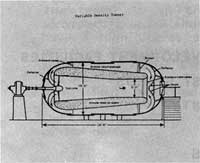 Variable density tunnel |
|
Full Scale Tunnel, Langley Research Center Built in 1931, the full scale tunnel (historic name--30-by 60-foot tunnel) allowed NACA engineers to test actual aircraft. Before and during World War II practically every high performance aircraft used by the United States was checked out in the full scale tunnel. For most of the war it was the only tunnel in the world capable of performing these tests. Although the full scale tunnel has been modified over the years, a major portion of the original fabric is intact. The versatility of the tunnel is demonstrated by the fact that it is still in active use, continues to be a major research tool, and contributes to the design of new generations of aircraft. Like the variable density tunnel, it receives little visitation, mostly by organized groups. There is no on-site interpretive media and little information at the visitor center. |
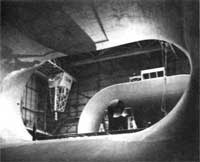 Full scale tunnel, Mercury space capsule testing |
|
Eight-Foot High Speed Tunnel, Langley Research Center Originally built in 1936, the eight-foot high speed tunnel (common name--eight-foot transonic tunnel) was the first to employ a slotted throat design. This landmark wind tunnel design, which was incorporated in 1950, gave aircraft designers accurate data on airframe performance in the transonic range and permitted them to test large models and actual working parts of airplanes. The basic structure of the tunnel is in poor condition and continues to deteriorate. A portion of the original test section is now used for offices and storage. The tunnel was deactivated in 1956 and has lost much of its original historic fabric because of lack of maintenance and changes in functional use. The tunnel is open to organized groups only and is seldom visited. There is no on-site interpretive media and little information at the visitor center. |
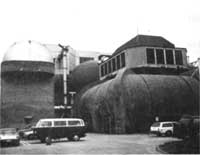 Eight-foot high speed tunnel, 1986 |
|
Unitary Plan Wind Tunnel, Ames Research Center The unitary plan wind tunnel (common name--unitary plan facility) was built between 1950 and 1955 and represents the continuing effort by NASA to provide American aircraft and aerospace industries with superior technical aeronautical research facilities after the end of World War II. In the 1960s and 1970s almost all NASA manned space vehicles were tested in this complex. The tunnel complex has been modified several times over the years, still exhibits a high degree of integrity, and continues to be used. The tunnel is open to organized tour groups on a limited basis and receives little visitation. There are no on-site interpretive exhibits, and there is no visitor center at the Ames Research Center. |
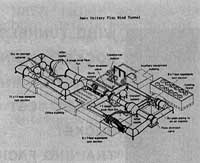 Unitary plan wind tunnel |
| ROCKET ENGINE DEVELOPMENT FACILITIES |
These sites illustrate the important role of the Lewis Research Center in developing hydrogen as a fuel for the Centaur and Saturn V rockets. The development of the Centaur and Saturn V rockets was crucial to the manned and unmanned space programs.
|
Rocket Engine Test Facility, Lewis Research Center The rocket engine test facility (common name--rocket propulsion test facility) was completed in 1957 and pioneered the technology necessary to handle hydrogen as a rocket fuel. The test facility is currently in active use and, despite modifications, retains a high degree of integrity. Groups can arrange to visit the facility, and interpretive exhibits are located in the shop area. The only interpretation at the Lewis visitor center depicting the rocket engine test facility is a film shown periodically. |
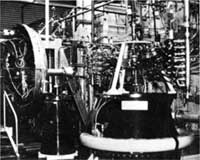 Rocket engine test facility, 1986 |
|
Zero-Gravity Research Facility, Lewis Research Center Built in 1966, the zero-gravity research facility is the only known facility of its size in the free world capable of performing tests in a reduced gravity environment and is the only NASA facility that can study the behavior of liquids in such an environment. Knowledge of the characteristics of liquids in a space vehicle was essential to the successful completion of the early American space program. The research facility, like the rocket engine test facility, is currently in active use and, despite modifications, retains a high degree of integrity. Groups can arrange visits, and interpretive exhibits are located in the shop area. The only interpretation at the visitor center is the film shown periodically. |
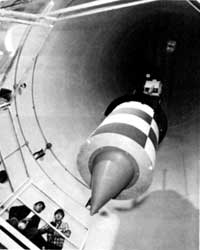 Zero-gravity research facility, 1966 |
|
Spacecraft Propulsion Research Facility, Plum Brook Operations Division of Lewis Research Center Built in 1968, the spacecraft propulsion research facility was designed for hot-firings of full-scale Centaur engines in simulated space conditions. It is the only facility that can hot-fire a large rocket while simulating the vacuum cryogenic temperatures and thermal radiation of space. The Centaur rocket launched some of the country's most important space probes. The facility has had few modifications over the years and retains its original fabric. It currently is maintained on standby status and would likely be modified if reactivated to accommodate new programs. The site is open only to organized groups and receives very little visitor use. There is no on-site interpretive media and none is provided at the Lewis visitor center 60 miles to the east. |
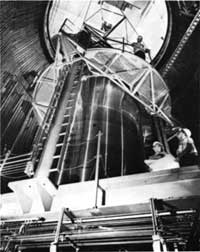 Spacecraft propulsion research facility, 1969 |
 Top
Top
Last Modified: Wed, Nov 29 2000 10:00:00 am PDT
http://www.cr.nps.gov/history/online_books/butowsky3/space2a.htm
![]()

